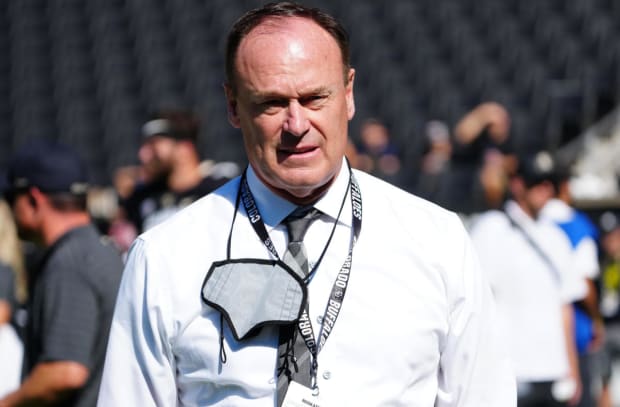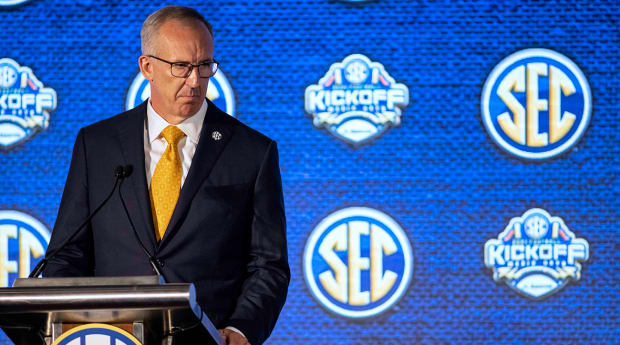View the original article to see embedded media.
SCOTTSDALE, Ariz.—Inside the Hyatt Regency at Gainey Ranch, the lavish resort on the outskirts of Phoenix, dozens of the most powerful people in college sports milled about, parading through the expansive lobby and basking in the sun on the terrace. But, the majority landed deep within conference meeting rooms, searching for answers to what’s become the latest seismic quandary in the industry—the rapidly escalating donor-fueled bidding war for college football and men’s basketball players.
“This is the time we have to put our stake in the ground. Enough! This is not acceptable,” frustrated Colorado athletic director Rick George says. “What we’re doing is not good for intercollegiate athletics, and it has got to stop.”
College leaders are strongly urging the NCAA enforcement team to begin investigating what they deem to be obvious recruiting violations, past and present. Donor-led collectives that have struck deals with players before they sign binding letters of intent are violating rules, says George, one of the leaders of an NCAA working group that will soon publicize additional NIL guidelines.

Ron Chenoy/USA TODAY Sports
Additional NIL guidelines, which the NCAA working group are currently finalizing, are expected to help regulate these deals that officials say are encouraging current players to remain on their teams and inducing recruits to sign with their schools, a developing situation Sports Illustrated detailed Monday. On Tuesday, SI reported on the impending release of the guidelines, which could happen as early as next week. George and Ohio State athletic director Gene Smith, also on the working group, confirmed the existence of the draft of guidelines.
The guidance clarifies existing NCAA bylaws that prohibit boosters from being involved in recruiting. Any booster or booster-led collective that has been found to have associated with prospects about recruiting—on another college team or in high school—will be found to have violated NCAA rules and put the booster’s school at risk of sanctions, George says. In addition, a booster, or booster-run collectives, “cannot communicate with a student-athlete or others affiliated with a student-athlete to encourage them to remain enrolled or attend an institution.”
“Just because we have NIL, it doesn’t eliminate the rules,” George says. “Everybody is like, ‘It’s NIL!’ I am totally in favor of NIL done right. It’s really good. [Athletes] should be able to monetize their NIL, but a lot of what’s going on out there is not NIL.”
Since the NIL concept began last July, college officials say there is well-documented evidence that boosters and collectives have arranged deals with prospects, many striking agreements before recruits signed with their new school. There is evidence of some boosters even hosting prospects at their homes and flying them to visit campuses, which all constitutes NCAA violations, leaders say.
“What’s happening now—I only know what I hear—is the inducements violate rules,” Smith says. “Hopefully this passes Monday and will give more clarity and guidelines. But then, [NCAA] enforcement has to enforce. The schools need to enforce, as well. At the end of the day, you have an institutional responsibility to enforce.”
The guidelines introduce more clarity to an interim NIL policy that provided only vague guidance that boosters are now skirting—if violations are found over the past 10 months since NIL first began, the NCAA should investigate those schools for sanctions.
“One-hundred percent,” George said. “We have to look at these deals. The NCAA has got to look at them, and if they are not within our guidelines, then hold them accountable and be firm.”
The enforcement staff has to be “ready to go” once the guidelines are released, says another Power 5 athletic director who requested anonymity. “They need to hit them and hit them hard and fast.”
However, it may be complicated.
NCAA enforcement has been less willing and perhaps unable to enforce existing bylaws, George and Smith say. For one, the organization is concerned that any enforcement will spark a bevy of antitrust legal challenges. Secondly, the NCAA enforcement staff is ill-equipped for a full-scale nationwide inquiry. It is down 15-20 members from COVID-19 pandemic layoffs. Smith says the association plans to eventually replace people.
In a warning shot at the NCAA itself, Pac-12 commissioner George Kliavkoff told SI on Wednesday if the NCAA does not start enforcing existing bylaws, leaders will find an alternate solution but did not specify what those solutions could be. Amid the uncertainty, Kliavkoff and SEC commissioner Greg Sankey traveled to Washington D.C. on Thursday for meetings with key U.S. senators in hope of further encouraging them to pass federal NIL legislation, which many believe will be the only practical solution for the latest mess but is unlikely to pass this year.
The NCAA enforcement’s staffing situation, which does not allow it to deeply pursue violators “is the biggest issue” the organization has, George says. But industry experts contend any enforcement will invariably generate lawsuits from wealthy donors. Given last summer’s Supreme Court loss in the Alston case and a bevy of state laws protecting the boosters themselves, what can the NCAA actually do?
“If they punish the kids, they will have lawyers lining up,” says Arizona-based sports attorney Greg Clifton. “There will be a class action lawsuit within 48 hours.”
Booster collectives have struck hundreds of deals since last July, and many of the donor-led groups have already pooled more than $5 million in a pseudo-player salary pool tagged for NIL. Boosters who spoke to SI say they are in compliance with their respective state laws governing NIL and/or the NCAA’s interim policy and they have proof to back that up.
“The NCAA has always said no pay-for-play and inducements and that’s what we’re seeing,” says Tom McMillen, president of LEAD1, an organization representing FBS athletic directors. “The NCAA could come down and … I just don’t know how you terminate deals. What are the enforcement mechanisms? Make kids ineligible?”

Vasha Hunt/USA TODAY Sports
Many boosters and collectives are managed by platforms such as Opendorse that assure they remain in compliance by tracking all athlete deals. Several are managed by sports agents and savvy attorneys who have kept documentation of their communication and the quid pro quos.
“I do think if the NCAA is able to go after the schools in some manner based on what the collectives are doing as representatives of a school’s athletics interest, that could put a stop to some of the inducement stuff going on right now,” says Mit Winter, a sports attorney who advises several collectives. “But if the NCAA declares an athlete ineligible, it’s likely that a lawsuit would ensue. Same with boosters and collectives.”
A plague on the NCAA for years, potential litigation was the primary reason the association abandoned plans last summer to implement a more permanent policy governing NIL, opening the door for wealthy donors to creatively maneuver around vague interim guidelines.
Now, as boosters for elite Power 5 programs bankroll football teams in a high-priced bidding war, the organization is shifting into attack mode. It raises more questions than answers.
“Whether it’s possible to un-ring the bell, it remains to be seen,” says Big 12 commissioner Bob Bowlsby, who is also on the working group. “It seems we would have been infinitely better off had we gone ahead and implemented the guardrails.”
George and several administrators were against the NCAA’s decision to eschew the permanent policy. “We shouldn’t have abandoned it,” he says. At the behest of the NCAA’s legal team and in a plan proposed by commissioners Sankey and Jim Phillips (ACC), as well as four other league executives, the plan was tabled.
“We pulled the police officers off the highway and everyone is now going 90 miles an hour,” Smith says. “Now we’re trying to put the officers back on the highway.”
Will the vehicles slow down?
“I don’t think all of the collectives will decide ‘OK, we’re going to listen to the NCAA now,’” Winter says. “With as much time and money they’ve spent putting them together, they aren’t going to want to stop. It’s a really interesting situation.”







